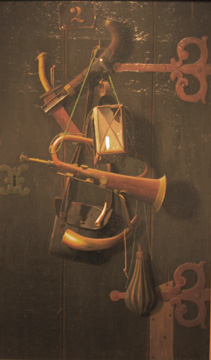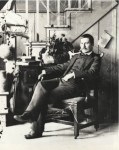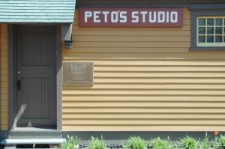
John Frederick Peto
American, 1854-1907
My Studio Door, 1895
oil on canvas
49 3/8 x 29 1/2 in.
SBMA, Gift of Mrs. Sterling Morton to the Preston Morton Collection
1960.76

Undated photo of Peto in his studio.
“What is important to recognize are the ways in which Peto modifies the traditional trompe l’oeil mode. While his paintings do not spell out a literal story, their elements often evoke narrative or anecdotal associations.”
- J. Wilmerding (1982) Archives of American Art Journal

You can visit The Peto Studio and Museum, at 102 Cedar Avenue, Island Heights, NJ 08732 (732) 929-4949
COMMENTS
John Frederick Peto’s work was almost forgotten until it was rediscovered in 1947. He is now considered among the most accomplished still life painters of his period, although he received little recognition during his lifetime. He modeled his work after that of his good friend, William Harnett. They often painted the same objects, and sometimes their work was mistaken for the others. Yet, Peto’s style was more abstract and the objects were arranged in a less orderly composition and with more originality. His handling of light and the usual choice of unpretentious objects was a major difference between these artists. The art historian responsible for his renewed recognition, Alfred Frankenstein said, “The marvel of Peto’s mature style is the extraordinary muted radiance of his color; it has a soft, powdery kind of texture which has caused more than one critic to invoke the name of Vermeer.”
“My Studio Door” is painted in the trompe l’oeil style, that which attempts to fool the eye. It is a collection of objects he collected, valued and are hung from a nail on his studio door. These humble objects, common equipment used by soldiers in the Civil War, are arranged loosely and are treated with an amazing degree of realism. The texture of the wooden door, the imposing hinges and lock, and the room number seem to recede. However the hanging objects seem to lift from the surface and intrude upon the viewer’s space. The dark background gives an intensification of reality. The brushwork is nearly invisible. Light reflecting off the metal and glass surfaces gives the feeling that we can touch them. Early viewers searched among the variety of objects trying to find order and relationships, and what they found was a restlessness which was at odds with the ordered traditions in painting up to that time. Peto was more interested in the shapes and colors of things, in their abstract qualities, in the humor of their disorderly placement, and in the decorative values of light and shade that he could coax from them, than in the things themselves. In the complex world of the present, examining a painting reflecting the simple things in life that have texture and smell, like weathered wood, leather books and treasured memorabilia seems to stimulate pleasant memories. John Frederick Peto was born in Philadelphia, one of four children of Thomas Hope Peto and his wife Catherine. His father was a gilder and a dealer in picture frames. These activities often exposed John to the world of art as the paintings came into their household to be serviced. Formal art training for Peto was brief. Catalogues of the Pennsylvania Academy of Fine Arts designated him as self-taught, yet the Academy also records him as a student there for the year 1878. By that time, Peto had already hung his shingle out as a painter on Philadelphia’s Spruce Street. Although seven of his paintings were accepted for exhibit at the Pennsylvania Academy over the years, he still had little recognition. In 1889, Peto, his wife and daughter moved to a home he designed and built on Island Heights in New Jersey. His work became darker, reflecting his mood--perhaps his suffering from isolation and neglect.
It wasn’t until 1946 that research on Peto’s paintings revealed several were sold fraudulently as having been painted by William Harnett. They were found to have Harnett’s forged signature painted over Peto’s by an unscrupulous dealer, many years after his death, in order to sell them for a higher price.
by Eunice Drell
Peto built his Queen Anne style house and studio in Island Heights, NJ, in 1890. The 2 1/2 story house, with its hipped roof, dormers, tower and gables, was home for his family. The building also included a large studio at the rear of the house where Peto surrounded himself with simple, utilitarian objects that were models for some of his greatest paintings. SBMA’s My Studio Door was painted there in 1895.
The property is also one of only a handful of historic house museums that celebrate the life of a famous American artist. It has remained in, and been cared for, by the Peto Family for 115 years, until acquisition in 2005 by a benefactor.
Today those same objects - the rusted horseshoe, musical instruments, lard oil lamp, umbrella, delicate china pitcher with matching cup and saucer, along with mugs and pipes - all adorn the walls and rafters of the Peto Studio so lovingly maintained until recently by his granddaughter, Joy Smiley.
Autobiographical and other enigmatic clues appear often in Peto’s letter-rack and office-board paintings. The business cards, invoices, and other snippets of paper he included in these works recall his father’s businesses as a dealer in frames and later in fire department supplies. Their sense of abstraction today strikes a surprisingly modern note. Phrases like Important Information Inside are playful references to ideas and facts, ambiguously concealing as much as they divulge. What is revealed throughout Peto’s work is a pre-occupation with the process of making art. Also conveyed is his feeling for the sister arts of music and literature, represented in his paintings of violins and varied arrangements of old books.
Much of his later work was brooding, even somber, and captured the unease of post-Civil War America. In a direct reference to the national sense of crisis, the artist painted his Reminiscences of 1865 (1897). The image of Lincoln appears in this and several other of the artist’s paintings, and it came to represent more than the martyred hero. For Peto, Lincoln took on the identity of a mourned father figure, closely associated with his own father, who dies in 1895.
My Studio Door is a different kind of commemorative painting, one whose goal isn’t the recreation of events, but is to trigger the collective memories of nation building.
The Civil War was a significant memory for John F. Peto’s generation, and it still is today, if not for slightly different reasons. This era is clearly important to Americans: most of the memorials and artworks in Washington depict events before the Civil War. The end of the Civil War ends the birth of the United States as a nation, and is tied to American national identity.
While someone like Peto could remember Gettysburg and Lincoln through his Civil War veteran father, today our memories of that time only exist through memorabilia, monuments and paintings. Although time has past, Peto’s paintings speak in a language that can be understood by anyone familiar with the images, dates and icons of the Civil War.
Peto’s obsession with the image of Abraham Lincoln, and Civil War objects, like the ones he used in My Studio Door, persisted from the 1890s until the early 1900s. It is believed largely attributed to the death of his father, a veteran of the Civil War, in 1895. His father supposedly recovered the bowie knife seen in the SBMA painting from Gettysburg.
Peto’s concern with dusty volumes and other worn objects takes on certain poignancy in the light of his own sense of mortality. His later years were marred by a painful kidney condition, Bright’s disease, which caused his death in 1907.
Compiled by Loree Gold, 2012
http://members.shaw.ca/caseymccarthy/samples/Casey_McCarthy_Civil_War.pdf
Source: Historic Building Architects, LLC Trenton, NJ. Includes Information Provided by Zakalak Associates.
Peto was one of the masters of "rack" paintings, which juxtaposed unrelated simple objects, such as postcards, torn theater or railroad tickets, portraits and tattered newspaper clippings. These commonplace and discarded motifs became the trademark of the American Trompe l’oeil School of painting during the period between 1870 and 1900.
SBMA CURATORIAL LABELS
In this unusually large still life, Peto amply demonstrates his illusionistic skills. Identified through an inscription on the back of the canvas, the painting depicts the door of the artist’s studio. The door is personalized, not by the trappings of his profession, but that of a typical outdoorsman, complete with a bone-handled bowie knife that, according to family legend, was a souvenir of the battle of Gettysburg, in which Peto’s father participated. Peto, a close emulator of still-life specialist, William Harnett (1848-1892), shows off his ability to distinguish shallow planes against the readymade plane of the trompe-l’oeil (French for ‘trick the eye’) ‘door’ using calculated tonal contrasts to establish the relative depth of the tangle of objects. The highlighted areas at the composition’s center are strategically positioned so that the bright white of the candle projects forcefully. Cast shadows and a subtle use of impasto on the metal hinges further distinguish the spatial relationship between the various still-life elements and their proximity to us.
- Ridley-Tree Reopening, 2021
